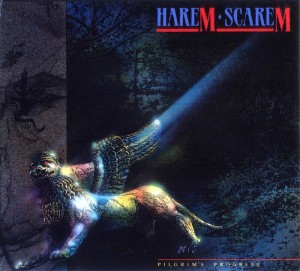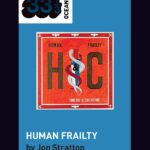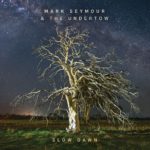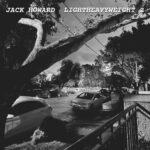Harem Scarem – Pilgrim’s Progress
![]()
Australian hard rock album featuring Barry Palmer, later the guitarist for Hunters and Collectors.
Released In: [Australia / NZ].
Release Date: 1986. Remaster: 1 February 2008.
Australian Chart Position: [Did Not Enter].
Availability: Moderately rare. Available new in CD form.
Value: A$15-A$30.
Legend:
![]() Commercial single.
Commercial single.
![]() Promotional single.
Promotional single.
Version: Aztec Music CD album.
Album length: 76 minutes, 36 seconds.
ReplayGain loudness: -8.84 (2008).
- Land Stand Man
- Miracle Mile

- Open Up and Bleed
- Run On Down The Line
- Lowdown
- Animal Tracks
- Cold Change
- Pilgrim’s Progress
- Hard Rain

- Let Me In
- Dead of the Night *
- Sweet Thing *
- Pilgrim’s Progress (live) *
- Let Me In (live) *
- Dogman *
- Love Attraction *
* Bonus tracks for CD remaster. B-sides and rare tracks.
Note: Harem Scarem featured Barry Palmer, later of Hunters and Collectors.
Harem Scarem emerged from Melbourne’s mid-80’s indie scene, but were arguably closer in sound to classic Australian blues-rock from a decade before (Dingoes, Coloured Balls, Rose Tattoo etc.) – infused with a heady mix of punk spirit and Stax soul.
Christopher Marshall’s extraordinary, passionate vocals combined with Charlie Marshall’s stonesy guitar (able assisted by Barry Palmer, Glen Sheldon, Peter Jones and Chris Wilson) created a timeless sound that would peak on this, their masterful 1986 album Pilgrim’s Progress – presented here, for the first time, remixed, remastered and with 6 bonus tracks.
Extract from the essay’s in the 16 page booklet Liner notes:
So many roads: Pilgrim’s Progress, and how we got there by Christopher Marshall
I remember when I was about twelve I once bought a cheap electric guitar from a friend at school. But then the strings cut into my fingers so I left it to gather dust in my room. Fortunately my brother Charlie picked it up and showed more perseverance than I did. Several years later we were rehearsing as a band of sorts. The founding reference points for what would become Harem Scarem were the unholy trinity of what every slightly mixed up teen outsider looking for release was into at that time: the Stooges, the Velvets and the Saints. I was also very taken with the raw aggression of 60s garage punk – a sound that I can still hear in “Love Attraction”, our first ever recording – made for a compilation on the Melbourne independent music scene, when we were still unsigned youngsters looking for a break. That recording started our relationship with Au Go Go Records who handled all our releases from then on.
At that early stage two old school friends were also in the band: Phil Wales who would leave a little while later and Glen Sheldon. Glen played guitar in a slashing kind of Ron Asheton style that perfectly suited the first step along the path of where we were headed. Charlie played bass by default – since we couldn’t find anybody else – and you can also hear his driving, muscular bass on “Love Attraction”.
Ultimately though, as the co-leader of the group with the core song writing duties, Charlie needed to move to rhythm guitar, a switch that occurred around the time of our first extended record, the Dog Man EP, which was recorded for the most part live to two track in an inner-city warehouse studio. It was at this stage that we started to think beyond our initial references and to work a little harder on crafting the sound that would ultimately come together for Pilgrim’s Progress. I was becoming obsessed with old blues records by the likes of Robert Johnson, Elmore James, John Lee Hooker and Howling Wolf. And so our next phase – and one that would set in train the essential change in our musical thinking – was to try to blend the original inspiration of the rough, punk drive of the Stooges et al. with a warmer, more rhythmic roots oriented approach that we got deeper into the more we listened to people like Doctor John, Exile period Stones, Tim Buckley, Al Green, Tony Joe White, Stax Records and others of their kind. We didn’t set out to emulate them directly – since we knew that, apart from anything else, there was no way we could match their evident years of experience and musicality. But it was more the spirit of the kind of deep feeling that they seemed to be able to conjure up so effortlessly that we were after.
Remember also that this was back in the days before CD re-releases and even before the Internet itself so that it often wasn’t that easy following up on obscure references to battered old vinyl. It took me two years, for example, to find a copy of Sly Stone’s There’s a Riot Goin On after being clued onto it a long time earlier through reading about it in Greil Marcus’s Mystery Train. It sounded extraordinary from what he was saying and when we finally did hear it, it turned out to be a key influence on Pilgrim’s Progress as well for its warm and fuzzy, rhythmic sound and incredibly free and loose singing style. Our knowledge of a lot of those early records also came from hanging out with people with better record collections than we had ourselves. Our first proper drummer, for example, Cliff Booth (who played with us up to Dog Man) was a key early friend along the way. He was from Perth and had played in more bands than we had – including a garage surf outfit called the Beach Nuts – and he had picked up more knowledge about the kind of music we were after in the process – I remember him introducing me to records like John Hammond’s Southern Fried, for example, and other things like that.
So over the course of 1984 and into the beginning of 1985 we started to make more systematic changes to the band’s line up to try to bring it closer to the evolving sounds in our heads. Charlie moved to guitar where his unique whomper stomper rhythmic style could be foregrounded and Glen swapped to bass. Since we were still heavily into the blues, we initially took on a harmonica player named ‘Dirty’ Kurt Lindtner and his friend Dave Moll on guitar. They were great. But we also wanted to avoid the problem of going too far in the other direction and sounding too ‘straight’. The last thing we wanted to do was to end up sounding like Canned Heat or some other boogie band doing blues covers. So those players ultimately moved on and we were left looking once again for new people who could take all of that roots background and convert it into something a little more shook up – a little wilder and less predictable, in other words.
Ultimately we found what we were looking for in the form of the great twin talents of Barry Palmer (on lead guitar) and Chris Wilson (on harmonica). Those two went way back since they had played for a long time in an incredibly tight and thoroughly road hardened R&B act called the Sole Twisters. Fortunately for us their band broke up around the same time as we were casting around for new people. They had all the chops – they could play those old blues licks backwards. But at the same time they were also looking for something a little more lateral and experimental. We also got extra lucky in finding a new drummer in the form of Peter Jones – fresh in from Sydney – who was (and still is) one of the most outstanding, exciting and gifted musicians we had ever encountered. His playing took us to a whole new level that we had never been able to reach before. This new incarnation clicked almost immediately and we were soon on the way to recording Pilgrim’s Progress.
We played live a lot in those days, so the songs on Pilgrim’s Progress had plenty of time to evolve and to be road tested on stage. It was an exciting scene back then and we took a lot of our energy from it as well. The Birthday Party had come through Melbourne in 81-82 and had blown everybody away thereby sowing the seeds for the next crop of headliners like the Hunters and Collectors, the Scientists, the Sacred Cowboys and the Moodists. They were all great to see live and they were supplemented by frequent interstate acts like Paul Kelly, the Go Betweens and the Laughing Clowns. The Clowns in particular had an improvisational jazz approach that we were particularly drawn to. There was a lot to take in. A night out at the Crystal Ballroom in St Kilda, for example, might involve three stages with as many as nine bands all appearing on the same bill. Further down the road, the Prince of Wales was also happening as a venue, and then the Esplanade overlooking the sea was the perfect setting for the end of the night when everything else was closing down. It was exciting to go out and see what was going on, and we very soon took an active role in all of that scene, playing scores and scores of gigs as a slowly building following grew in our wake.
All good things must pass, however, and it felt as if we had only just got it together with Pilgrim’s Progress and then started thinking about what to do next, than it started to unravel somewhat as well. There were the inevitable musical tensions, as there always are. Charlie started to prefer more tightly structured, shorter songs, with a number of different sections in them – whereas I got more into the idea of rolling, loose grooves. I liked the longer, slower jams like Pilgrim’s Progress and Let Me In. I liked, in other words, to stretch things out, to leave it a little loose and unresolved, so as to be able to reach into the groove and find something new to add to it each night. Charlie, on the other hand, got a bit tired sometimes of just hanging about on a couple of chords for ever. Of course both points of view were equally valid. And looking back on it now I can see that we were also very young and unrelenting with each other and on those around us. Everything was intensely black and white and now or never in those days.
So, we pushed ourselves a little too hard, the fragile equilibrium of the band gave way, and we took our separate paths. Glen Sheldon went off to work in publishing – in fact the first book he ever published, with Cliff Booth as co-publisher, was Vivien Johnson’s excellent biography of Radio Birdman. For his part, Charlie kept the name of Harem Scarem and went on to make one more album under that title before going out on his own and releasing many Cds as a solo act over the years. Barry Palmer was immediately picked up by Hunters and Collectors, before going on to front Deadstar and then moving into producing more recently. Chris Wilson went solo as well, after an initial period touring and recording with Paul Kelly and the Coloured Girls, and Peter Jones played with various acts including even Crowded House for a period. All of this is a tribute of course to how tremendous those players were – and I have to say that it was a great feeling to be singing for that band on a good night. Harem Scarem were a band that could rock out incredibly hard in one moment and then turn things around in an instant and open the music out so as to float and weave around it in the next. To be lost in that moment of unpredictable potentiality – of sensing our way collectively into something strong and fresh and new – that was a great thing. And I can still hear all of that combined experience, sweat and inspiration, together with the sound of us listening to each other to see what will happen next, embedded in the grooves of Pilgrim’s Progress.
I hope you enjoy listening to it too.
Thankyou
Harem Scarem would like to thank all of our past members, together with our beloved partners, families and friends for putting up with this unresolved thing for all these years. Thanks also to the following people for their invaluable help on the recordings, photos, layouts etc.: Jane Brown, Teddy Cleaver, Sean Cousins, Mark Ferrie, Simon Grounds, John Hanstein, Paul Kotz, Francine McDougall, Greta Moon, Bruce Milne, David Michols, Callum Orr, Gavan Purdy, Conway Savage, Marilen Tabacco, David Vodica, Clinton Walker, Ted Lethborg and everybody at AZTEC Music. Finally to Michael Lynch for his support and encouragement on this project as always.
Personnel
Tracks 1-14 Christopher Marshall, vocals / Charlie Marshall, rhythm guitar / Barry Palmer, lead guitar / Glen Sheldon, bass / Peter Jones, drums / Chris Wilson, harmonica & saxophones on Hard Rain / Conway Savage: piano on Miracle Mine, Open Up & Bleed and Let Me In
Track 15 Christopher Marshall, vocals / Charlie Marshall, bass / Cliff Booth, drums / Glen Sheldon, guitar / Dave Moll, guitar / Kurt Lindtner, harmonica
Track 16 Christopher Marshall, vocals / Charlie Marshall, bass, backing vocals / Cliff Booth, drums / Glen Sheldon, guitar / Phil Wales, guitar
Songwriting Credits
All tracks Marshall / Marshall / Harem Scarem, except track 10, Marshall / Marshall / Sheldon / Harem Scarem and track 3, Pop/Williamson/Control.
Recording Information
Tracks 1-12, recorded early 1986 at Herzog Studios, Elwood and the Esplanade Hotel, St Kilda. Produced by John Archer and Harem Scarem, engineered by John Archer.
Tracks 13 & 14 recorded live by John Archer at Melbourne University, 1986.
Track 15 recorded October 1984 at John Cook’s Studio, Hardware Lane, Melbourne, produced by John Archer and Harem Scarem.
Track 16 recorded early 1984 at Squawk Studios, Highbank, Kyneton, produced by Steven Morrow and Harem Scarem.
Release Information
Tracks 1-10 released as Pilgrim’s Progress (ANDA-55), 1986
Singles: Hard Rain (ANDA-52); 1986.
Miracle Mile (ANDA-56); 1987.
Tracks 13-14 included on limited edition 12″ promotional disc (ANDA-57), 1987
Track 15 released on Dogman EP (ANDA-30), 1984
Track 16 released on Asleep at the Wheel: Various Artists, Melbourne (ANDA-33), 1984
This compilation remixed by T. Cleaver, remastered by Cal Orr at Digital Zero.
Photo Credits
Francine McDougall: pages 2, 16, 17, back cover.
John Hanstein:pages 9, 10 11, 15, inside digi-pack.
Photographer unknown: pages 13, 22.
Prepared for release by Christopher Marshall, Charlie Marshall and Ted Lethborg. Remixed by T. Cleaver. Mastered by Cal Orr at Digital Zone. Design and layout by Paul Kotz (Small Studio) with assistance from Mark Ferric (Cool City Design). Digi-Pak design and layout by Dave Macken.
Aztec Music would like to thank: Christopher Marshall, Charlie Marshall and Michael Lynch.
Special thanks to the members of Harem Scarem who created the music on this release: Christopher Marshall, Charlie Marshall, Barry Palmer, Glen Sheldon, Peter Jones and Chris Wilson together with all the earlier members of the band and guest musicians.
www.aztecmusic.net Preserving Australia’s rich musical heritage
This compilation (C)2008 Aztec Music. 19-21 Johnston Street, Collingwood, Vic 3006 Australia. www.aztecmusic.net. Unauthorised duplication is a criminal offence. Made in Australia.






